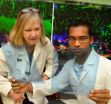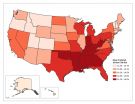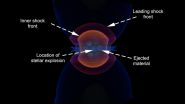(Press-News.org) A newly identified signaling pathway that stimulates glucose uptake in brown fat cells might be useful for treating type 2 diabetes and obesity, according to a study in The Journal of Cell Biology.
When the body encounters cold temperatures, the sympathetic nervous system activates adrenoceptors on the surface of brown fat cells to stimulate glucose uptake from the bloodstream. Brown fat cells then use this glucose as a fuel source to generate body heat. Glucose uptake also can be induced by insulin. However, although insulin-stimulated glucose-uptake is well understood, the mechanisms involved in the adrenoceptor-dependent process have been unclear.
Now, researchers in Sweden reveal that the mTORC2 signaling pathway is the key regulator of adrenoreceptor-stimulated glucose uptake in brown fat tissue in mice. The pathway, which involves a protein kinase called mTOR, stimulates the transport of a glucose-importing protein called GLUT1 to the surface of brown fat cells.
"One of the most interesting characteristics of this newly discovered signal pathway is that it differs from the signal pathway triggered by insulin," says senior author Tore Bengtsson from the Department of Molecular Biosciences, Wenner-Gren Institute, Stockholm University. "This means that the signal pathway in brown fat can most likely be activated even in patients with type 2 diabetes, where insulin signaling is impaired."
In addition to being an effective tool for controlling blood sugar levels in type 2 diabetes patients, these findings suggest that stimulating the mTORC2 pathway to take advantage of the energy-burning power of brown fat might be effective as a weight loss therapy.
INFORMATION:
Olsen, J.M., et al. 2014. J. Cell Biol. doi:10.1083/jcb.201403080
About The Journal of Cell Biology
The Journal of Cell Biology (JCB) is published by The Rockefeller University Press. All editorial decisions on manuscripts submitted are made by active scientists in conjunction with our in-house scientific editors. JCB content is posted to PubMed Central, where it is available to the public for free six months after publication. Authors retain copyright of their published works, and third parties may reuse the content for non-commercial purposes under a creative commons license. For more information, please visit http://www.jcb.org.
Research reported in the press release was supported by the Australian Research Council, Australian National Health and Medical Research Council (NHMRC), Swedish Research Council, Novonordiskfonden, Stiftelsen Svenska Diabetesförbundets Forskningsfond, the Magnus Bergvall foundation, and the Carl Tryggers foundation.
How brown fat fuels up to combat type 2 diabetes and obesity
2014-11-10
ELSE PRESS RELEASES FROM THIS DATE:
The University leads research and teaching into spirituality in health care
2014-11-10
THE term 'spirituality' is now widely used to describe the qualities that give people hope, meaning and purpose. In the case of patients, it can aid their recovery. The University of Huddersfield has become a key centre for research into spirituality and how it can be integrated into health care teaching and practice.
Articles, overseas conference presentations and now close links with an NHS trust are among the recent outputs and activities of the University's Spirituality Special Interest Group, based in the School of Human and Heath Sciences. Established for ten ...
Accidental discoveries that changed the world (video)
2014-11-10
WASHINGTON, Nov. 10, 2014 -- Throughout the history of science, many major discoveries came accidentally. Sometimes they came from recognizing potential in an unexpected product or even a failed recipe's waste. Other times, discovery came out of pure desperation from a seemingly dead-end experiment. This week, Reactions celebrates those happy accidents that ended up changing the world in the first episode of a new sub-series, "Legends of Chemistry." Check out the video here: http://youtu.be/Xowen_a787Y.
Subscribe to the series at Reactions YouTube, and follow us on Twitter ...
'Darting' mice may hold clues to ADHD, autism and bipolar disorder
2014-11-10
A darting mouse may hold an important clue in the development of Attention Deficit Hyperactivity Disorder (ADHD), autism and bipolar disorder, according to a study by a Vanderbilt University-led research team recently published in the Proceedings of the National Academy of Sciences.
The transgenic mouse, into which was inserted a rare human genetic variation in the dopamine transporter (DAT), could lead to improvements in the diagnosis and treatment of these all-too-common brain disorders, said Randy Blakely, Ph.D., the report's senior author.
The mutation, which has ...
Major blood vessel constrictor contributes to vision loss in premies
2014-11-10
AUGUSTA, Ga. - A gene known to play a major role in constricting blood vessels also appears to be a major player in the aberrant blood vessel growth that can destroy the vision of premature babies.
Endothelin gene expression is greatly increased in the retinal tissue of a mouse model of retinopathy of prematurity, a condition that significantly affects about 1,500 infants annually, resulting in blindness in about half those babies, according to researchers at the Medical College of Georgia at Georgia Regents University.
The finding points toward a new therapy to help ...
New state level data demonstrate geographical variation in 10-year cardiovascular risk
2014-11-10
Ann Arbor, MI, November 10, 2014 -- Public health researchers seeking to determine an individual's risk of developing cardiovascular disease (CVD), coronary heart disease (CHD), or stroke have previously relied on national US data, such as that provided by the National Health and Nutrition Examination Surveys (NHANES). Now, new data compiled and evaluated by researchers at the Centers for Disease Control and Prevention (CDC) provide information at the state level for the first time, paving the way for targeted intervention programs. Their results appear in the American ...
Study identifies pre-symptomatic markers for hemorrhagic viruses like Ebola
2014-11-10
(Boston)--A new study has found it is possible to distinguish between different hemorrhagic fevers, including Marburg (Ebola cousin) and Lassa before the person becomes symptomatic.
The study, which appears in the journal BMC Genomics will allow for the development of better diagnostics, especially during the early stages of disease, when treatments have a greater chance of being effective.
Hemorrhagic fevers include Lassa, which is endemic in Western Africa and Marburg, which causes sporadic outbreaks in Africa associated with high rates of mortality. The early symptoms ...
New materials yield record efficiency polymer solar cells
2014-11-10
Researchers from North Carolina State University and Hong Kong University of Science and Technology have found that temperature-controlled aggregation in a family of new semi-conducting polymers is the key to creating highly efficient organic solar cells that can be mass produced more cheaply. Their findings also open the door to experimentation with different chemical mixtures that comprise the active layers of the cells.
Polymer solar cells are a delicately controlled mixture of a polymer donor and a fullerene acceptor. The cell is created by adding a solvent to the ...
Nurse navigators may aid colon cancer screening follow-up
2014-11-10
SEATTLE--Group Health patients with a positive screening test for colon cancer (a stool test or sigmoidoscopy) tended to be more likely to get the recommended follow-up test, a diagnostic colonoscopy, if nurse navigators contacted them than if they got usual care. This is according to "Results of Nurse Navigator Follow-up After Positive Colorectal Cancer Screening Test: A Randomized Trial" in the November-December Journal of the American Board of Family Medicine, led by Beverly B. Green, MD, MPH, a Group Health physician and a Group Health Research Institute associate investigator. ...
Astronomers dissect the aftermath of a supernova
2014-11-10
In research published today in the Astrophysical Journal, an Australian led team of astronomers has used radio telescopes in Australia and Chile to see inside the remains of a supernova.
The supernova, known as SN1987A, was first seen by observers in the Southern Hemisphere in 1987 when a giant star suddenly exploded at the edge of a nearby dwarf galaxy called the Large Magellanic Cloud.
In the two and a half decades since then the remnant of Supernova 1987A has continued to be a focus for researchers the world over, providing a wealth of information about one of ...
On-demand conductivity for graphene nanoribbons
2014-11-10
New York | Heidelberg, 10 November 2014 -- Physicists have, for the first time, explored in detail the time evolution of the conductivity, as well as other quantum-level electron transport characteristics, of a graphene device subjected to periodic ultra-short pulses. To date, the majority of graphene studies have considered the dependency of transport properties on the characteristics of the external pulses, such as field strength, period or frequency. The new findings have now been published in EPJ B by Doniyor Babajanov from the Turin Polytechnic University in Tashkent, ...






